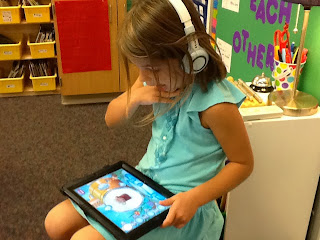With individualized words for spelling and the varied individual student rate of-for mastering spelling words... administering individualized spelling assessments to 26 students to monitor progress, identify known and unknown words, and determine individualized words for learning requires extensive "time" (which there never seems to be enough of... ugh!)
After many trials and errors... I finally found an iPad app that allows me to assess individual student's spelling, monitor progress, identify known and unknown words, determine individualized words for learning, and... the Things To Learn iPad app!
 |
a first grader's accurate spelling of high-frequency words
is assessed in isolation
with the Things To Learn iPad app |
I created spelling assessments (within the app) for the 15 high-frequency spelling word lists (30 words per list) and "shared" (emailed and imported) the assessments of each of the 15 word lists with the 26 student iPads.
I created a "Write Words" (our high-frequency spelling words) assessment "book" within the app on each student iPad (assessments were imported into the "Write Words" assessment book) and created a student account within the app. I customized the app to have assessments results emailed to my teacher email account and "assigned all tests to all users" (providing each student access to all Write Word assessments) in the app settings.
As analysis of a student's individualized word lists and authentic writing indicate developed "mastery" of a word list, the First Grade Butterfly accesses the appropriate Write Word list assessment in the Things To Learn iPad app.
The app includes the capability to "write" or "type" the words. The Buttetflies use a stylus (that mimics the use of a pencil or pen) to "write" each word in the assessment.
The app includes the capability to have the word repeated (unlimited). The Butterflies use headphones (promoting optimal ability to "hear" and identify each word) with the Things To Learn app.
Post assessment- the Butterfly self-assesses the accurate spelling of each word (comparing his/her written recording of the word to the typed word) and "shares" the assessment result through email.
The app includes the capability to reassess words missed and/or reassess the entire word list.
The app includes the options to "assess" or "practice" word lists, for words to be assessed in "sequential" or "random" order (I have "random" order selected for all assessments), and the option to "write" or "type" the word (the selection of "type" includes the option to select "case sensitive" and automatically analyzes the spelling accuracy post-assessment).
 |
a screenshot of word lists
in the "Write Words" assessment book |
 |
a screenshot of the written recording of the spelling word "you"
in the "list 1- RED" assessment
in the Things To Learn iPad app |
 |
a screenshot of the "self-assessment"
of the spelling accuracy for each word assessed |
 |
a screenshot of the "results"
of a Write Word assessment
with the option to "share results" (envelope icon) |
 |
the initial page of a "shared" assessment
received through email
-with the word assessed, student written recording of the word (with a stylus),
and the student self-assessment of spelling accuracy |













































